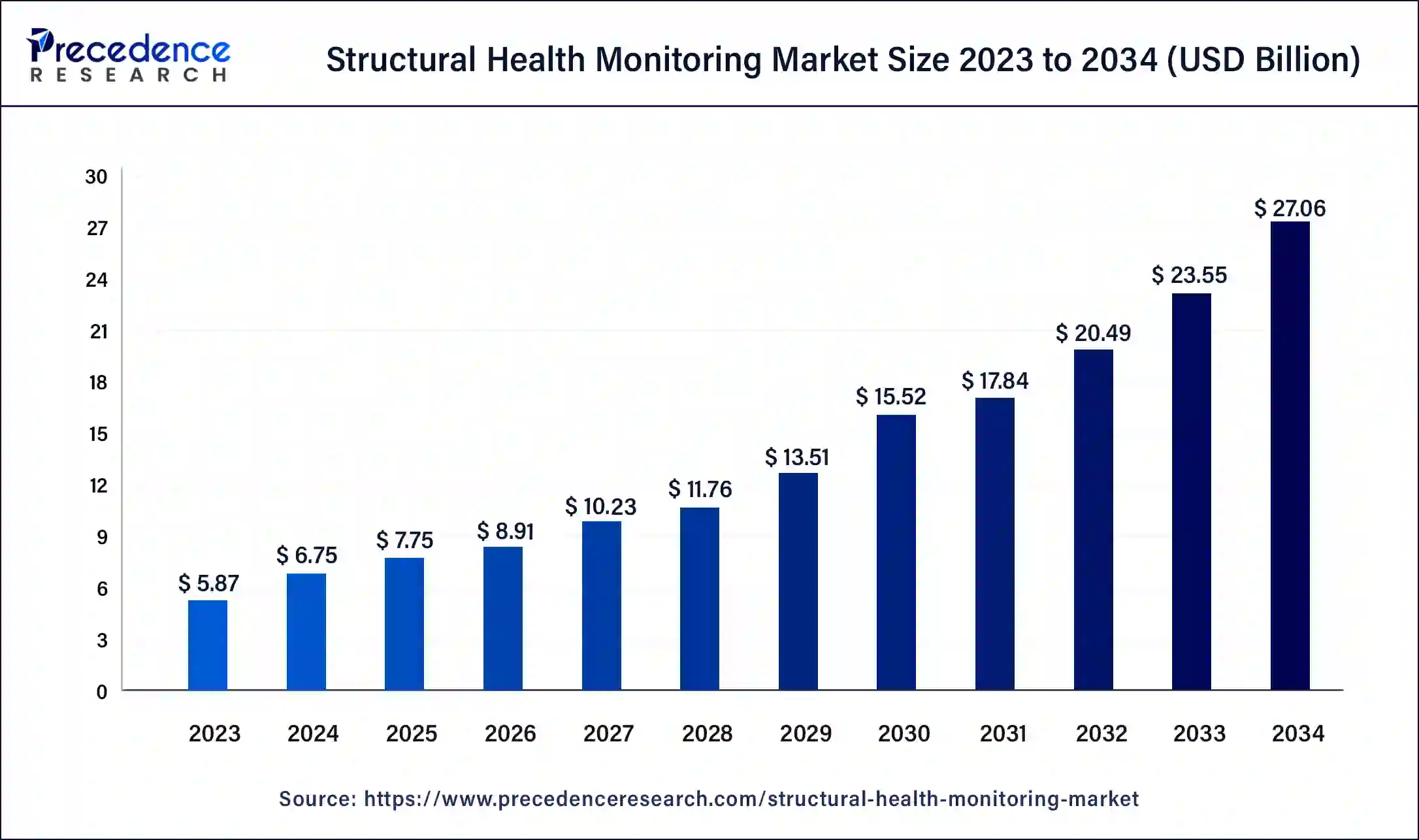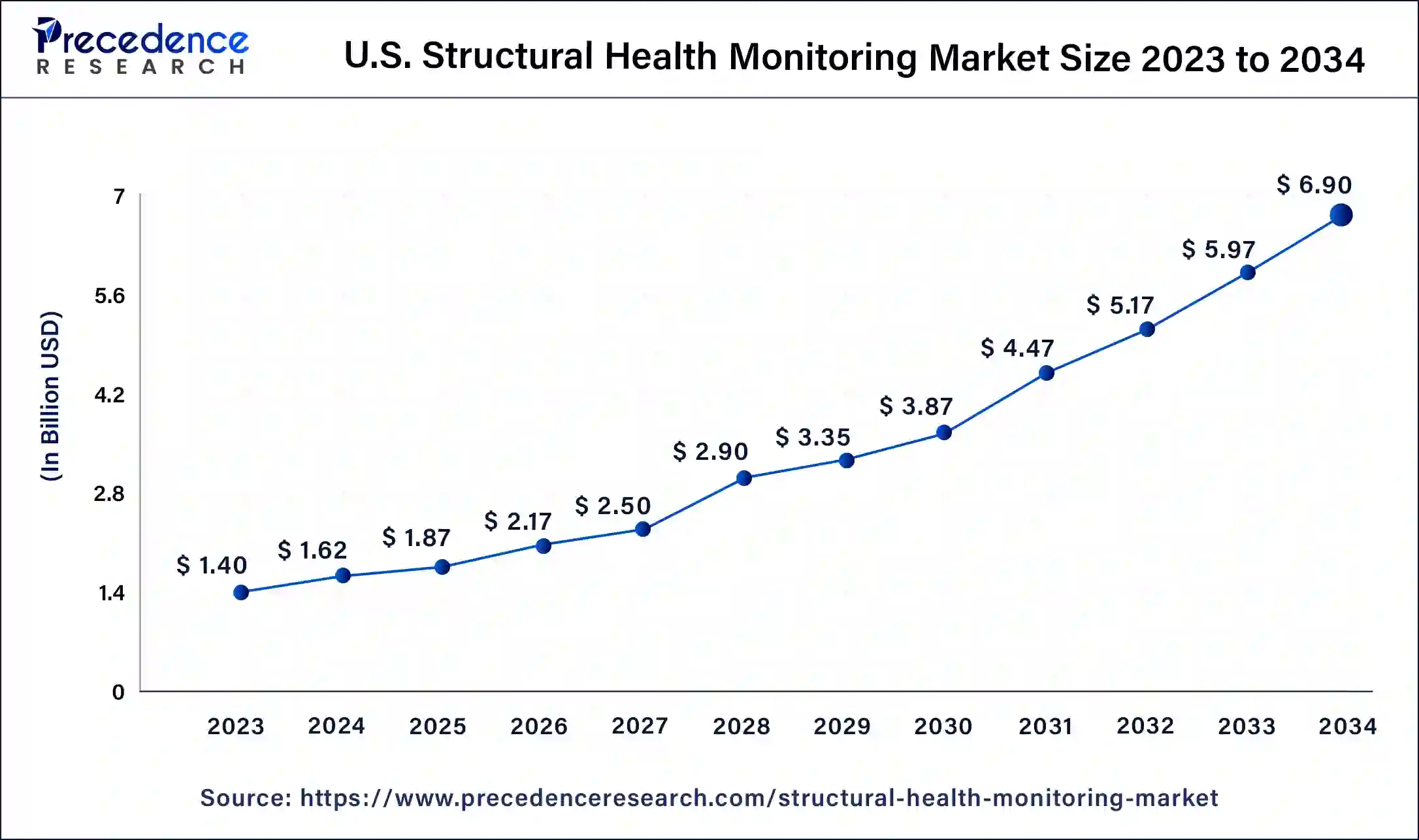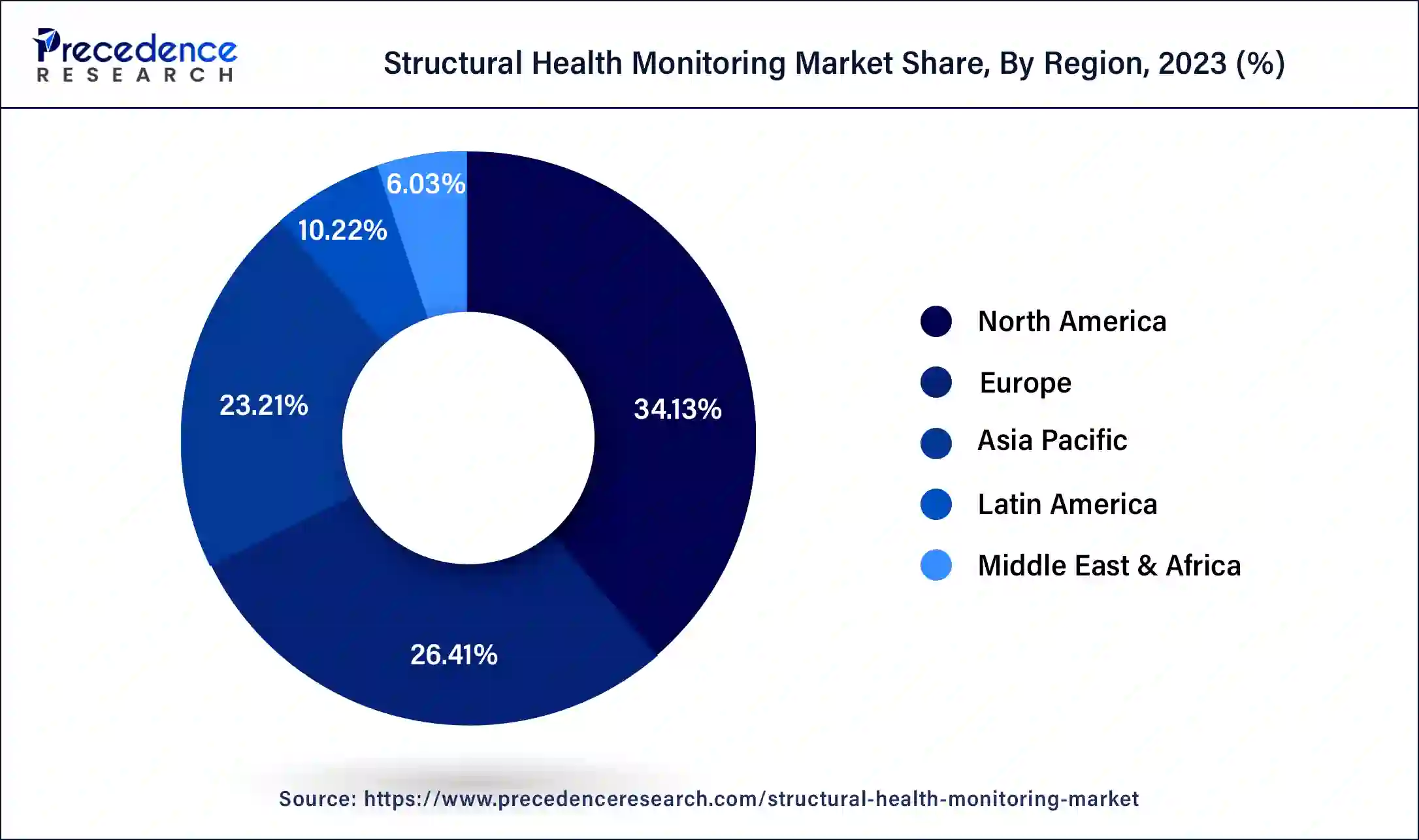August 2024
Structural Health Monitoring Market (By Solution: Hardware, Software & Services; By Application: Bridges & Dams, Building & Stadiums, Vessels & Platforms, Airframes & Wind Turbines, Large Machines & Equipment; By Technology: Wired, Wireless) - Global Industry Analysis, Size, Share, Growth, Trends, Regional Outlook, and Forecast 2024-2034
The global structural health monitoring market size was USD 5.87 billion in 2023, calculated at USD 6.75 billion in 2024, and is expected to reach around USD 27.06 billion by 2034. The market is expanding at a solid CAGR of 14.9% over the forecast period 2024 to 2034. The North America structural health monitoring market size reached USD 2 billion in 2023.

The U.S. structural health monitoring market size was estimated at USD 1.40 billion in 2023 and is predicted to be worth around USD 6.90 billion by 2034, at a CAGR of 15.6% from 2024 to 2034.

North America dominated the market with the highest market share in 2023, the region is expected to witness a significant growth rate during the predicted timeframe. The dominance of the region in the market is driven by substantial support from the governments of the nations. North American industries and institutions prioritize education and awareness about the benefits of structural health monitoring. Engineers and professionals are well-informed about the importance of monitoring infrastructure which drives the adoption in the region.
Asia Pacific is expected to witness the highest CAGR during the forecast period. Many countries in the region, such as China and India are investing heavily in infrastructure projects, creating a substantial market for structural health monitoring technologies to ensure the safety and longevity of these investments. Awareness about the benefits of such monitoring systems in the region is increasing among stakeholders in the construction and civil engineering sectors.

Market Overview
A structural health monitoring system is a technology that is utilized for monitoring purposes during the construction of infrastructure or even lifetime monitoring of the infrastructure, such as dams, bridges, stadiums, etc. The technology is used for the detection and characterization techniques for complex structures such as tunnels, bridges, and wind turbines. This technologically advanced system is embedded with several sensors that detect the safety and security issues of the structure. The structural health monitoring system includes processes like sensors, data acquisition, diagnostics, and data transfer for the safety, integrity, and monitoring performance of the structure.
Structural health monitoring is one of the important tools in civil engineering for ensuring and improving the safety and integrity of the structure. Structural health monitoring accesses the data from the sensors which are installed in the system for monitoring the activities. The data which is obtained by the sensors are analyzed for the detection of changes in structural degradation, damages, and hazards. Structural health monitoring is preferably used in aerospace engineering, civil engineering, and mechanical engineering applications to ensure the safety and trustworthiness of the structure.
The structural health monitoring system is responsible for the functionality and safety of the structure. The sensors are embedded during the process of construction that observe the structure’s access and safety of the construction lifelong. Structural health monitoring evaluates the integrity of the structure after natural calamities like an earthquake. It reduces the time and maintenance cost of the construction by structural monitoring and assessment in real-time and cost-effectiveness. The structural health monitoring process collects data on the real-time performance of structures.
Increasing real-estate infrastructure across the world is driving the growth of the responsible and advanced system which can improve the solidity and safety of the structure. The structural health monitoring system is the best alternative for civil engineers to fulfill the requirements of the technology. The emergence of smart cities, the construction of dams, bridges, malls, and other complex construction infrastructure would highly contribute to the growth of the structural health monitoring market during the forecast period.
| Report Coverage | Details |
| Market Size in 2023 | USD 5.87 Billion |
| Market Size in 2024 | USD 6.75 Billion |
| Market Size by 2034 | USD 27.06 Billion |
| Growth Rate from 2024 to 2034 | CAGR of 14.9% |
| Largest Market | North America |
| Base Year | 2023 |
| Forecast Period | 2024 to 2034 |
| Segments Covered | By Solution, By Application, and By Technology |
| Regions Covered | North America, Europe, Asia-Pacific, Latin America, and Middle East & Africa |
Technological advancements in sensor technology
An array of sensors measuring stress, strain, vibration, tilt, humidity, and temperature, among other factors are critical to the condition of the structure and its surroundings, makes up a standard health monitoring system. Following recent advances in sensor technology for structural health monitoring, a variety of structural health monitoring sensors have been developed. Technological advancements in sensor technology are observed to act as a potential driver for the market’s growth during the forecast period. One of the most prominent technological advancements in the field is the development and integration of smart sensors for structure health monitoring purpose. These sensors are prominently designed by aiming energy efficiency and sustainability while offering the benefit of wireless technology. Such smart sensors are intended to collect data more accurately than traditional sensors.
Variability in data
Due to a number of practical prerequisites and underlying assumptions, implementing structural health monitoring (SHM) approaches with a high Technology Readiness Level (TRL) is still a difficult task. The linearity hypothesis and robustness to the inherent unpredictability of data are two of the challenges that deserve particular attention. Moreover, the precision degradation may be caused due to sensor’s fault which can offer bias monitoring outcomes. All these concerns are associated with the variability of data which is observed to act as a restraint for the market.
Rising number of smart city projects
Smart cities often undergo extensive infrastructural development, including buildings, roads and even other utilities. Structural health monitoring is crucial in ensuring the safety and longevity of these assets, creating a substantial demand for monitoring systems. Smart cities prioritize the safety and reliability of their infrastructure, structural health monitoring systems help identify potential issues and hazards early, allowing for timely maintenance and minimizing the risk of accidents or failures. The rising number of smart city projects underscores the importance of structural health monitoring systems ensuring safety and efficiency. Thus, the factor is expected to present multiple opportunities for the market.
The hardware component segment dominated the market in 2023, the segment will continue to grow at a significant rate during the forecast period. The growth of the segment is attributed to the rising adoption of hardware components in construction infrastructure like buildings, dams, stadiums, etc., there are several types of hardware components such as sensors, data acquisition hardware, structural health monitoring system, data interpretation models, response protocol, etc. The sensors are one of the most important factors in the structural health monitoring system. The sensors record and convert in digital values various physical parameters that can create structural changes. The sensors include strain sensors, temperature sensors, inclinometers, accelerometers, humidity sensors and etc. Retrofitting existing structures with sensors and monitoring equipment often requires specialized hardware solutions, further driving the demand in the hardware segment.
The software segment is expected to grow at a notable rate. The growth of the segment is attributed due to the rising need for monitoring system software at construction sites. The software segment provides the visual presentation of data and gives the structure behavioral insights to the monitoring team for the analysis of the data by the team and to prevent the system from damage and safeguard the structure from failure. The rising number of infrastructure projects worldwide is expected to expand the growth of the software segment.
Technology Insights:
The wired segment had a significant share of the market in 2023. The structural health monitoring system has been adopted by several sectors with wired technology in structural health monitoring for the continuous monitoring of several types of structures. In wired technology for monitoring, there are no limitations for accessibility or data transfer also they provide better connectivity. The wired structural health monitoring system is already installed by various structures like buildings, dams, and bridges in several countries. The wired system allowed the continuous transfer of data in real-time.
The wireless segment is expected to dominate the market during the forecast period. Structural health monitoring is the most advanced monitoring method and has been gaining popularity in recent times, with the wireless technology in SHM increasing gradually in the past 10 years. Wireless networks are also known as smart sensors, these sensors are affordable when applied in the monitoring of big structures with high structure and safety requirements. The energy efficiency and cost-effectiveness offered by wireless structural health monitoring technology will continue to fuel the segment’s expansion.
Application Insights:
The bridges and dams segment has dominated the market with a significant share in 2023. The dominance of the segment is attributed to the presence of strict regulatory framework from regulatory bodies to manage and monitor the real-time condition of dams and bridges. The pattern of construction of bridges and dams is evolving significantly. The structural health monitoring system provides valuable information about the internal structure and maintains safety, and continuous operation by undertaking hazard mitigation and timely risk. The growing number of bridges and dam construction globally is contributing to the growth of the segment.
The buildings and stadium segment is expected to grow at a significant rate during the forecast period. The rising sports events and increasing interest of the population in the entertainment and sports industry would be contributing to the development of stadiums across the world. As well as the rising residential and commercial infrastructure results in the development of the construction sector. All these factors contribute to the growth of the segment and result in the increasing adoption of the structural health monitoring market during the forecast period.
Recent Developments:
Segments Covered in the Report:
By Solution
By Application
By Technology
By Geography
For inquiries regarding discounts, bulk purchases, or customization requests, please contact us at sales@precedenceresearch.com
No cookie-cutter, only authentic analysis – take the 1st step to become a Precedence Research client
August 2024
October 2024
March 2025
December 2024